|
|
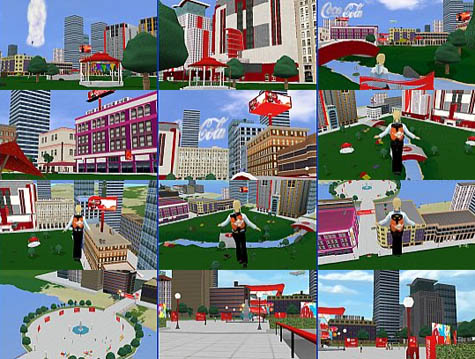 [Image: Some examples of work by Imaginary Forces]. [Image: Some examples of work by Imaginary Forces].For those of you in Los Angeles, 1) consider kidnapping me and driving me back there in a van full of architecture books and coffee, because I can't even believe how much I miss that place, and 2) consider stopping by the Apple Store tonight in Santa Monica to hear Tali Krakowsky, Director of Experience Design at Imaginary Forces, speak about "trends in the fusion of design, technology and architecture." It's the narrative infrastructure of built space: Transformations in design thinking, inspired by emerging technologies and a fascination with storytelling, are changing the entertainment, educational, corporate and retail environments of the 21st Century. In her session, Krakowsky will break down interactive environments into their components: re-imagining content in motion, re-imagining media delivery systems, and re-imagining smart, interactive spaces, [to] examine several key projects in terms of process and design methodology. The talk is tonight at 7pm, and it's located here. Tell Tali I said hey.
EMI has announced that " unsold copies" of Rudebox, by British pop star Robbie Williams, "will soon be used to resurface Chinese roads."
More than a million copies of the CD "will be crushed and sent to the country to be recycled," we read, where they "will be used in street lighting and road surfacing projects."
This reminds me of a house I visited back in September, in Chicago – about which I wrote a short article for the March 2008 issue of Dwell – wherein the owners had pulverized boxes of old vinyl records, added them to a glass aggregate, and used that to surface the floor of their master bathroom. You could actually see tiny, vaguely recognizable pieces of crushed 45s catching sunlight near the toilet... National Geographic also covered the house.
In any case, does all this imply some strange new infrastructural claim to fame?
"You know that CD they used to pave the King's Road?" a man asks you, putting his coffee down as if to emphasize the point. He crosses his arms. "I played bass on that."
(Thanks, Steve!)
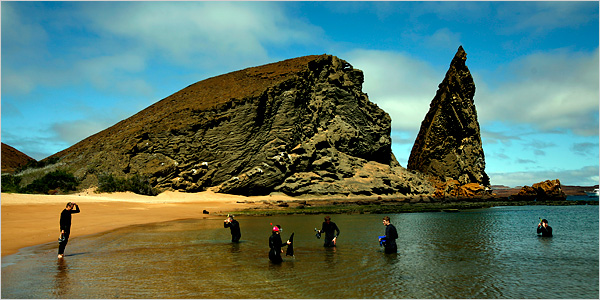 [Image: ©Michael Nagle for The New York Times]. [Image: ©Michael Nagle for The New York Times].Seeing this photo of the Galapagos Islands, with its strange, almost hand-painted color scheme, like something from an old British postcard, made me wonder if perhaps we might yet discover a way to deep-inject colored dyes into active magma chambers, producing technicolor flows of liquid rock in a million years' time. Volcanoes will erupt in Chile, forming bright green hillsides, yellow cliffs dotted with blue boulders. A fine pink gravel will wash up and down the steaming beach. So can we introduce color into underground reservoirs of liquid rock – with the effect that, far after humans have died off, these weird and fantastic displays of dyed geology will arise, poking up beneath eroded soils, revealing themselves in fissures after earthquakes? Colored bulges of bedrock push toward the earth's surface, seeking the sun. And isn't that exactly what will happen anyway, as mineral belts of industrial waste and plastics compress over time into new stratigraphies? We could pattern future hillsides like Scottish tartans. Like shirts from J. Crew. Like Sol Lewitt: give him a whole magma chamber to play with. Like some vast underground ink-jet cartridge ready to print colored landforms onto the surface of the earth. Can we dye rock itself? Unsupervised geological interventions are the future of landscape architecture. What Ted Turner did for film, we will do for geology: the re-colorization of the planet. (Photo courtesy of The New York Times).
Two Chilean scientists believe that the world's largest tectonic plate, located beneath the Pacific Ocean, is "tearing apart," and possibly on the verge of cracking in two, New Scientist reports. 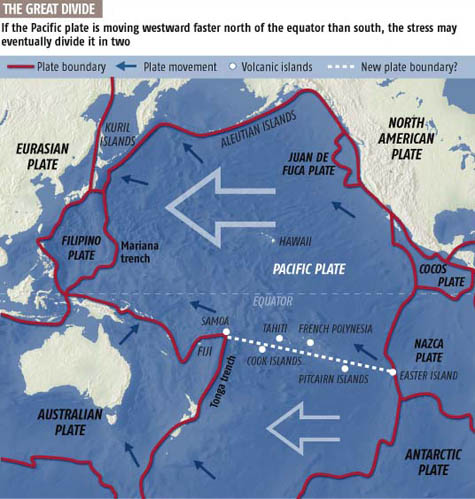 [Image: Courtesy of New Scientist]. [Image: Courtesy of New Scientist].The northern half of the plate has been drifting west, into the Mariana subduction zone, nearly seven times faster than the westward drift of the southern half, creating a massive linear cramp of tectonic stress that may eventually snap altogether. Indeed, the scientists suggest that "several archipelagos in the south Pacific – running from Samoa to Easter Island – including the Pitcairn and Cook islands, and French Polynesia," are evidence that this " future border," as the scientists call it, has already begun leaking magma, producing tropical island chains. The seafloor is unzipping, one could say. So will future archipelagos bloom there, like rocky fruits of the sea – and could we prepare for this? Mapping those islands in advance, even naming them? And might someone yet design a new, sub-oceanic architecture for these and other future spreading zones, awaiting the arrival of new landmasses, slowly explosive islands that don't exist yet? The virtuality of the tectonic. And, for now, could we arrange a kind of psychonavigation of this future shear zone, some boatbound summer design studio on a yacht, involving martinis, bikinis, salt-bleached beards, and SPF 100, taking echo-locative readings of the Pacific seafloor, determining edges and boundaries for these islands yet to come? Perhaps there is a whole new version of the earth that remains both immanent and imminent inside the one we currently live on – with all due implications for tomorrow's philosophy. Or geophilosophy, as Deleuze would say, sipping pinot grigio on a boat in the mid-Pacific.
I'm back from London now to find the news cycle absolutely abuzz with so many interesting stories that it'll be hard to keep up – but I'll start posting the best of the best in a bit. 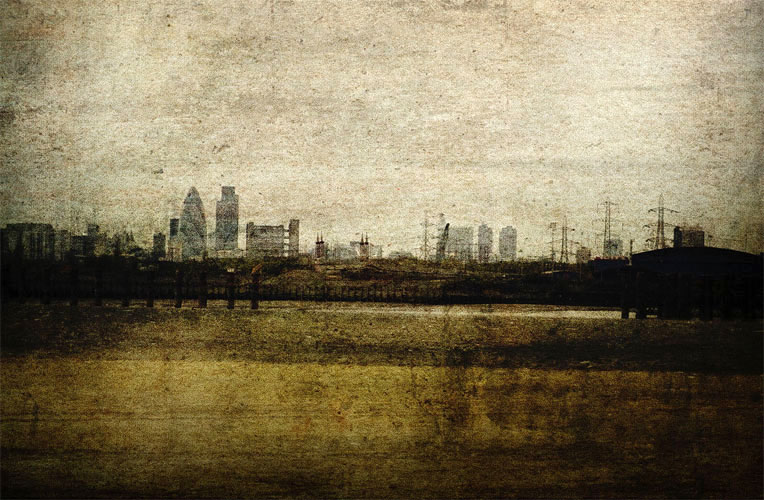 [Image: A photo from Jacob Carter's ridiculously gorgeous River Thames Series]. [Image: A photo from Jacob Carter's ridiculously gorgeous River Thames Series].First, though, last week's lecture was a blast; I talked way too fast, of course, bungling several points in the process, but, in the main, I had a great time and can only hope that everyone who came out on a Wednesday night in London – including my father-in-law! – to hear perhaps a bit too much about geology and not enough about offshore structures, or about the colonial politics of naming alien territories, or about urban iterative architecture, had a good time, as well. The Bartlett may or may not be uploading a film of the lecture at some point, meanwhile; until then, a few notes from the talk can be seen courtesy of Matt Jones and Mark Simpkins. Also, if you attended BLDGBLOG's recent lecture at SCI-Arc then you would have heard a lot of this before – but you would have missed out on instancing gates and billboard houses and the Indonesian mud volcano and China Miéville's "slow sculptures" and what I thought was a really fun Q&A. 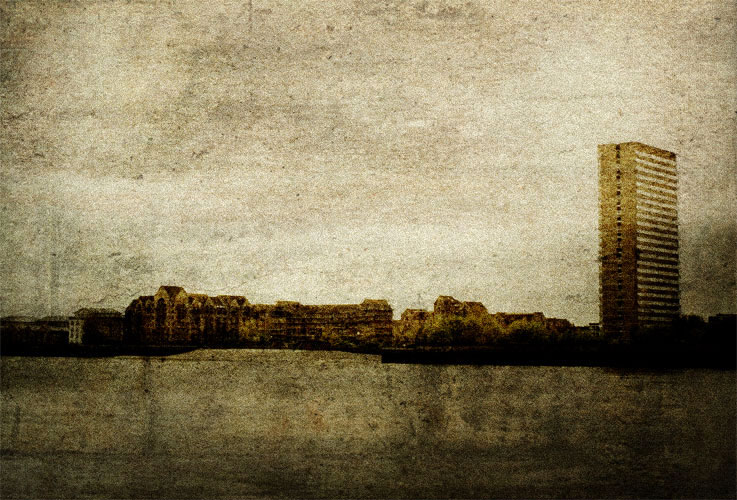 [Image: Another one from Jacob Carter's River Thames Series]. [Image: Another one from Jacob Carter's River Thames Series].So here's a huge thanks to Iain Borden for hosting the lecture, and to Alex Haw, both for setting it up and for introducing me. Expect more from Alex here on BLDGBLOG, by the way, hopefully soon. Now: back to regular posting... (Note: The title of this post is a line from London Orbital by Iain Sinclair).
A British novelist has been awarded legal damages in excess of £100,000 because she writes thrillers, not literary masterpieces. What's at fault? She's been inhaling fumes from a nearby shoe factory. 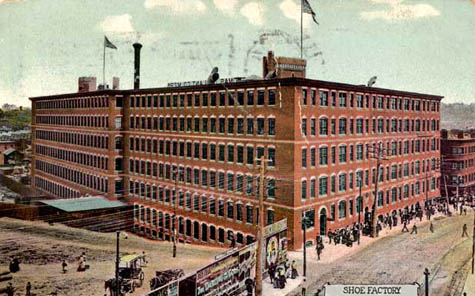 The author "claimed to have become so intoxicated" by the fumes that "she was reduced to writing thrillers." Indeed, the fumes grew so intense "that she was unable to concentrate on writing her highbrow novel, Cool Wind from the Future, and instead wrote a brutal crime story, Bleedout, which she found easier." That book went on to sell 10,000 copies. So there are several unspoken arguments being put forward by her claim. Such as: 1) Literary judgement. Why is one "reduced" to writing crime thrillers? Perhaps Henning Mankell is more interesting than, say, Zadie Smith. This writer thinks so, at least. I.e. me. Perhaps the traumatized British author under discussion here should actually owe money to the shoe factory – a small percentage of her royalties, for instance – or at least an acknowledgment in the book. 2) Environmental causality. Perhaps BLDGBLOG is caused by the fact that I do not inhale fumes from a nearby shoe factory. Perhaps I find it difficult to concentrate on anything but architecture because of my city's aroma... I'd thought it'd been all the coffee. 3) Paranoia. Perhaps you, right now, are inhaling something that prevents you from writing your own Ulysses. Perhaps you are being held back by untraceable smells. Perhaps your life is being quietly reshaped by something you can neither see nor properly talk about, some vast and mysterious influencing machine that manipulates you from the outside. Perhaps that machine is a giant shoe factory. 4) Theft, unauthorized use of services, and/or copyright infringement. Perhaps this woman has been using the shoe factory's fumes without permission. Perhaps, Delphi-like, they have been wafting through the neighborhood for someone else's use, mesmerizing home scribblers into a state approaching hypergraphia. Perhaps there was another writer in the flat next door furiously pounding out thrillers and loving every minute of it. Perhaps this woman had no right to use the fumes in the first place – like taping a film whilst sitting at the cinema. Put the pen down, love. These fumes aren't for you. It's a form of neurochemical shoplifting. 5) Scapegoating. Perhaps you can't finish the novel you started writing last summer because of London. You don't live in London – in fact, you've never been there – but it's distracting you. It's forcing you to write emails to friends, instead. You haven't touched your novel in ages. You should sue London... Or perhaps all those buildings you see everyday are preventing you from being a good architecture critic. It's not your eye for detail – it's the buildings you're forced to write about. Perhaps the streets you take to work each day are not inspiring you to travel abroad and be interesting and do something fun with your life. Perhaps your coworker's cubicle makes you terrible at data entry. Perhaps nothing is your fault at all. Perhaps the color of Manhattan taxi cabs prevents you from writing good music. You're now homeless. You prepare to sue. 6) Aromatherapeutic innovation and/or the future of global perfume. In 2010, Burberry will release a new scent. It will smell like the fumes of British shoe factories. Within days of buying your first bottle you begin to convulse – and write thrillers... So is your neighborhood causing you to write – or not write – highbrow novels? Can you prove it? Or do you only cook spaghetti because of the sad little street you live on – when, really, you're a gourmet chef...? What is your city doing to you? (Thanks, Steve T!)
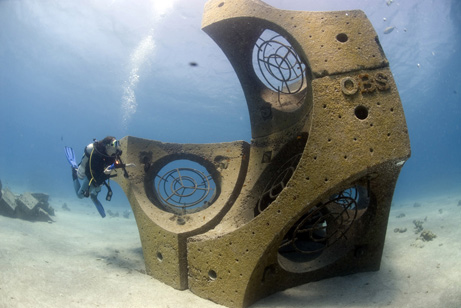 [Image: Photo by Eran Brokovich for National Geographic News]. [Image: Photo by Eran Brokovich for National Geographic News].For the next 8 or 9 days I will be in and out of range, possibly unable to post. I'm flying to London tonight and I will be back the following weekend. However, I will be giving a lecture at the Bartlett School of Architecture on Wednesday, January 23, at 6:30pm – so if you're in London, and you've got an overwhelming need to hear about artificial reefs and tectonic warfare and urban soundscapes and climate change and sovereign trapdoors and dungeon instancing and the future of surveillance and offshore utopias – in other words, all the things that normally appear here on BLDGBLOG – then please feel free to come out, bring your friends, and roar for urban speculation. The more the merrier. It's my first international lecture, and I'm excited! 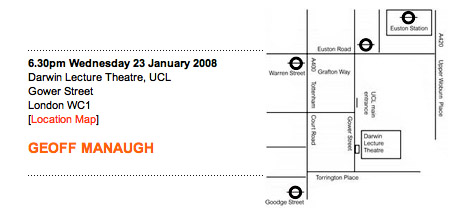 I believe, as well, that I'll be introduced by Alex Haw, who helped set up the lecture in the first place, so it'll be worth coming out just to hear him speak. And then I'll be back posting next week. If you've never been to BLDGBLOG before, by the way, as good a place as any to start reading might be here and here. Hope to see some of you there! (Meanwhile, don't miss the White House Redux competition!)
I'm excited to announce that I'm on the jury for a new design competition, called White House Redux, the purpose of which is to design a new home for the U.S. Presidency.  It's a speculative project, to be sure – but a fun one, and I can't wait to see what comes up. Here's the brief: What if the White House, the ultimate architectural symbol of political power, were to be designed today? On occasion of the election of the 44th President of the United States of America, Storefront for Art and Architecture, in association with Control Group, challenge you to design a new residence for the world's most powerful individual. The best ideas, designs, descriptions, images, and videos will be selected by some of the world's most distinguished designers and critics and featured in a month-long exhibition at Storefront for Art and Architecture in July 2008 and published in Surface magazine. All three winners will be flown to New York to collect their prizes at the opening party. Register now and send us your ideas for the Presidential Palace of the future!  Continuing: Few people realize the extent of the White House, since much of it is below ground or otherwise concealed by landscaping. The White House includes: Six stories and 55,000 square feet of floor space, 132 rooms and 35 bathrooms, 412 doors, 147 windows, twenty-eight fireplaces, eight staircases, three elevators, five full-time chefs, a tennis court, a bowling alley, a movie theater, a jogging track, a swimming pool, and a putting green. It receives about 5,000 visitors a day.
The original White House design, by James Hoban, was the result of a competition held in 1792. Over the centuries, presidents have added rooms, facilities and even entire new wings, turning the White House into the labyrinthine complex it is today.
What if, instead of in 1792, that competition were to be held today? What would a White House designed in 2008, year of election of the 44th President of the United States, look like? That's the question, then: If you were to design a residential office complex for the U.S. President, what would it look like? Perhaps London's GLA? Or the CCTV Building? Or Selfridge's, Birmingham? Or the Kunsthaus Graz? Would it be stylistically European – or Latin American, or African, or Asian? Prefab? Rammed earth? Perhaps an updated Nakagin Capsule Tower? Or would it be a Walking City? Maybe a helicopter archipelago? Maybe algae-powered, or billboard-bound, or an inhabited dam? Would it be ironic, self-deprecating, imperial, solar-powered, walled off behind anti-missile batteries, or anachronistically neoclassical and made of limestone? All of the above? Here are the specs. The jury consists of Beatriz Colomina, Stefano Boeri, Liz Diller, John Maeda, myself, and Laetitia Wolff. So step up and submit. I'm genuinely excited about this. Show us your best! Think big, think small, think detailed. Think abstract. Change history.  [White House Redux is sponsored by Control Group and Storefront for Art and Architecture]. [White House Redux is sponsored by Control Group and Storefront for Art and Architecture].
"The Arab emirate of Dubai will build a replica of Lyons," we read, "under a $685M deal signed with the French city last week." This brings up the interesting question of whether an entire city can franchise itself.
 [Image: Place de la Trinité, Lyon, photographed by Emiliano Calero Cortés]. [Image: Place de la Trinité, Lyon, photographed by Emiliano Calero Cortés].
The resulting metropolis will be called Lyons-Dubai City, and it "will cover an area of about 700 acres, roughly the size of the Latin Quarter of Paris, and will contain the university, a hotel school, a film library, subsidiaries of Lyon museums and a football training center run by Olympique Lyonnais."
It will only be complete, however, if the existing population of Lyons (aka Lyon) is cloned, raised in the exact same way as the source population, reading the same books, dating the same people, working in the same offices, etc. – so that they can wander round, eating tomato salads in sidewalk cafes, stunning future tourists from China. It'll be a cross-cultural Tom McCarthy novel – precise and choreographed reenactments on the scale of two cities – or perhaps some surreal, heavily Gallicized remake of Westworld: instead of being killed, however, you simply get over- fromage'd frites.
This reminds me of Ignacio Padilla's ultra-short story " The Antipodes and the Century," discussed on BLDGBLOG nearly a year and a half ago. In that story we read how "a great Scottish engineer, left to die in the middle of the desert, is rescued by a tribe of nomads," and, upon being nurtured back to health, he "inspires" his saviors "to build an exact replica of the city of Edinburgh in the dunes."
This "shimmering haze of towers" is soon buried by a sandstorm.
Indiana Jones pt. 5.
(Thanks, Katie!)
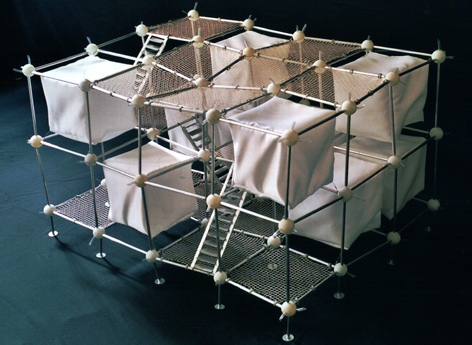 [Image: Maison elastique by Etienne Meneau]. [Image: Maison elastique by Etienne Meneau].Don't miss the maison elastique, or elastic house, a modular system of somewhat theatrical scaffolding, by Etienne Meneau – "made for those who like instability."    [Images: More views of Elastic Houses by Etienne Meneau]. [Images: More views of Elastic Houses by Etienne Meneau].One or two of those might be fun to bounce around in here in California during an earthquake... Deformable grids absorbing tectonic shock. Popping back into place. Waiting for the next one. There are some interesting videos on Etienne's site.
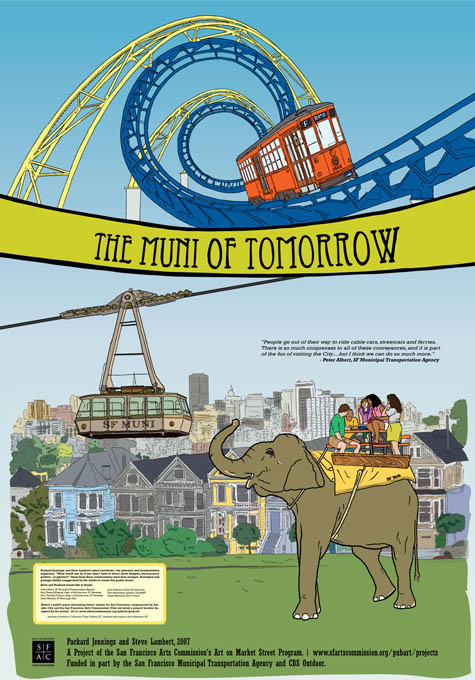 [Image: By Steve Lambert and Packard Jennings – you must view larger!]. [Image: By Steve Lambert and Packard Jennings – you must view larger!].Another project that's been knocking me out these past few weeks is " Wish You Were Here! Postcards from our Awesome Future," by Steve Lambert and Packard Jennings. A brief description: Packard Jennings and Steve Lambert asked architects, city planners, and transportation engineers, “what would you do if you didn’t have to worry about budgets, bureaucracy, politics, or physics?” Ideas from these conversations were then merged, developed, and perhaps mildly exaggerated by Steve and Packard to create a series of 6 posters for the San Francisco Arts Commission’s Art on Market Street Program. These posters are actually now on display at bus kiosks down along Market Street in San Francisco. A little bit of urban speculation on your way to work. 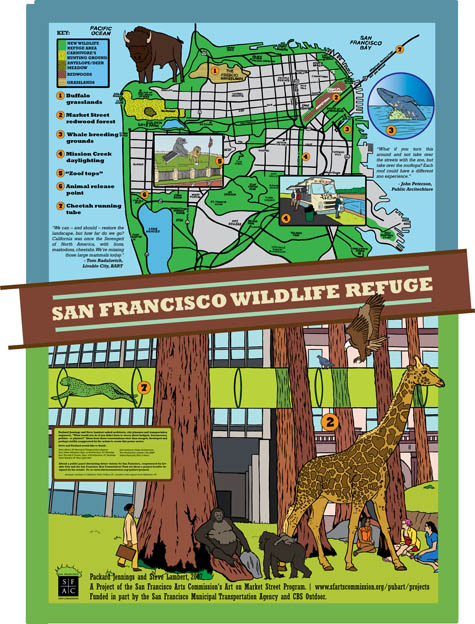 [Image: By Steve Lambert and Packard Jennings – view larger!]. [Image: By Steve Lambert and Packard Jennings – view larger!].I love these things! Every city should do this. And they should hire Steve Lambert and Packard Jennings, because their illustrations are ace. Seriously, every city should do this: Produce visions of your city in the future, then pin them up at bus shelters. That's how SCI-Arc and The Bartlett should start exhibiting student work. 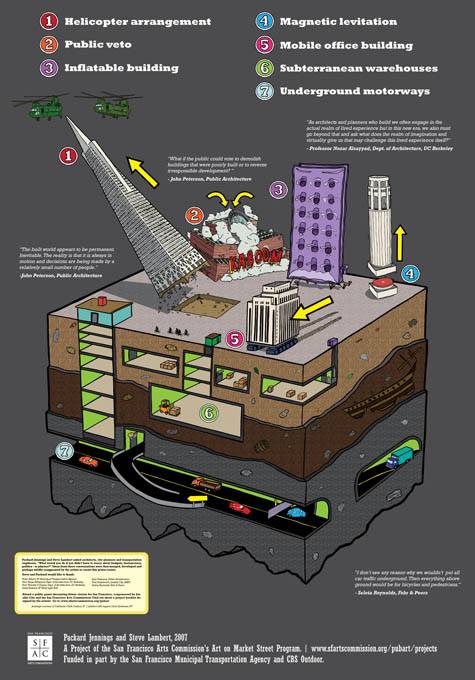 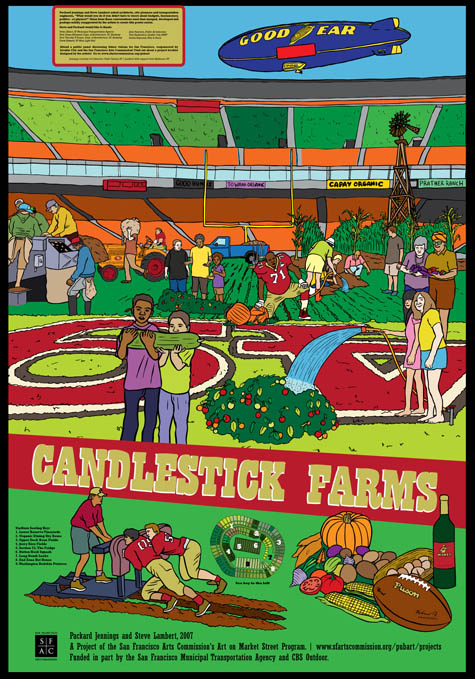  [Images: By Steve Lambert and Packard Jennings – view larger: top, middle, bottom]. [Images: By Steve Lambert and Packard Jennings – view larger: top, middle, bottom].Be sure to check out the whole Flickr set, which includes documentation of the posters in situ. (With huge thanks to both Ross Perlin and Steve Lambert for pointing these out!)
"By the end of January," The Scotsman writes, "it's essential to be back in Edinburgh... where Nicholas Bone's intriguing performance company Magnetic North stages a version of Henry Thoreau's Walden, one of the most famous essays ever written on the idea of self-sufficiency and human harmony with nature." The set has been designed by Sans Façon. 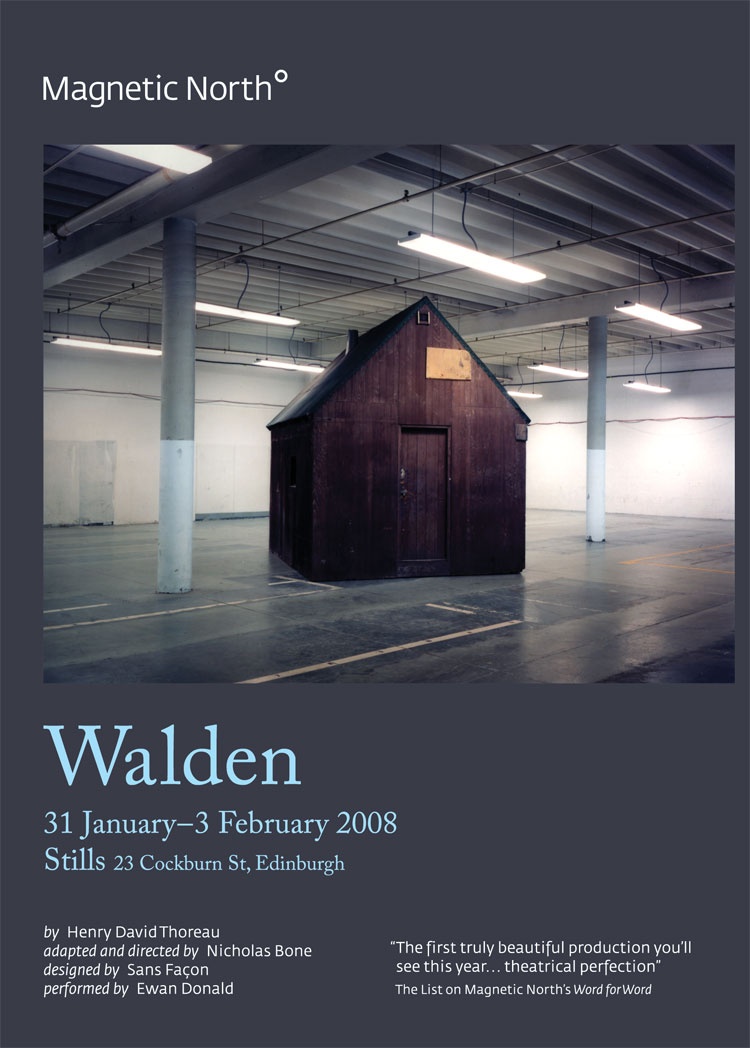 [Image: Photograph ©Richard Barnes. More info at Magnetic North]. [Image: Photograph ©Richard Barnes. More info at Magnetic North].What blows me away, though, is the suggestion, in the image, above, that one could build a kind of personal retreat in the middle of an underground car park. You're fed up. You want to be alone, to spend some time getting to know your own inner tendencies, how you react to things free from the influence of others, what you think about when you're not at work or out drinking with friends or consumed with constricting deadlines; you want to sit alone in the emptiness, surrounded by nothing, implanting yourself there in the void, all deliberate solitude and meditation. But you don't go to the woods. You don't go out to some canyon somewhere. Forget nature. You build a cabin in an underground car park and you eat canned spinach. You're the only one there. Sleeping at night is almost literally sublime: the whole place roars with unseen machines, ventilation flues droning at all hours. It's like living inside a resonator, a whorling microclimate inside the earth, cavernous. No one knows you're down there. No one's ever parked this far underground. Like the grain of sand that becomes a pearl, you know you'll someday re-emerge, psychologically transformed by that encounter with stale air and concrete. In Walden, Thoreau famously wrote: I went to the woods because I wished to live deliberately, to front only the essential facts of life, and see if I could not learn what it had to teach, and not, when I came to die, discover that I had not lived... I wanted to live deep and suck out all the marrow of life, to live so sturdily and Spartan-like as to put to rout all that was not life, to cut a broad swath and shave close, to drive life into a corner, and reduce it to its lowest terms, and, if it proved to be mean, why then to get the whole and genuine meanness of it, and publish its meanness to the world; or if it were sublime, to know it by experience, and be able to give a true account of it in my next excursion. But what Thoreau didn't have was a good underground car park – that modern solitude of slanted floors and cold air. Car parks will be the catalysts for our future evolution.
The design pictured below – for "a track, supported above the water by pontoons," forming a sea-based airport on top of which planes could land – was published in Science and Mechanics back in 1936. The project was "not, of course, intended for deep-sea operation, like the proposed floating seadromes, but for the quiet water of harbors."  [Image: From Modern Mechanix, originally published in 1936 – the same year Raiders of the Lost Ark takes place, on a completely unrelated note]. [Image: From Modern Mechanix, originally published in 1936 – the same year Raiders of the Lost Ark takes place, on a completely unrelated note].Those deep-sea "floating seadromes," however, are really quite interesting. An idea by engineer Edward R. Armstrong, seadromes were " steel islands" that would be "anchor[ed] 375 miles apart across the Atlantic." [Each seadrome] will have an unobstructed airplane runway 1,200 ft. long by 200 ft. wide. At the mid-sides the platform will project to give room for a hotel (with restaurant and bar), hangars, storage sheds, weather bureau, offices, hospital wards, lighthouse. Platform and buildings will be 80 ft. above calm water level. Because no Atlantic waves have ever been seen more than 45 ft. high, it is improbable that the runway ever will be awash. The buoyancy columns with their stabilizing disks will reach 160 ft. below water level. That is considerably deeper than any wave action has ever been noted. In other words, the seadromes wouldn't fare too well if they got hit by a rogue wave... We learn that Armstrong "long planned to anchor his first full-size seadrome midway between Manhattan and Bermuda. Studying hydrographic charts of the region he figured that there must exist a high spot on the ocean floor about where he would like it. He asked Secretary of the Navy Charles Francis Adams to send a survey ship to check his calculations. He was right." There was, indeed, "a little plateau" out there, to which one of Armstrong's floating islands could anchor. By flying from one seadrome to the next, Armstrong believed that aerial transit time between North America and Europe could eventually be cut to "as low as 20 hrs." According to American Heritage, Armstrong's "chain of seadromes would stretch across the Atlantic to the Azores, from which planes would continue on to Spain, with connections to the rest of Europe. The seadromes would be equipped with patrol boats and Seasleds so that, as a newspaper article explained, 'a disabled plane forced down … between seadromes, could be reached in five hours or less.'" However, the seadromes were also extra-constitutional spaces located outside landed sovereignty. Some interesting governmental questions arise here – such as: If you were born out there, and raised there, and educated there, what passport would you hold? What if no country would receive you – leaving you to wander, Odysseus-like, from one seadrome to the next, flying the Atlantic trade winds in a state of infinite anti-residential exile? To whose laws would you be bound? The idea of floating airports has mutated into a variety of similar such schemes, meanwhile, including so-called modularized ocean basing systems for the U.S. Navy, also known as mobile offshore bases. And then, of course, there's SeaCode...
Might the cultivation of "shiny crops" be a good way to reflect solar energy back into space – thus helping cool the surface of the planet in the fight against global warming?  These "fields of shiny crops," the Guardian reported this morning, "could send more of the sun's heat back into space, and even reverse temperatures in parts of the world." "Encouraging farmers to grow shinier crops" would presumably be most successful "in agricultural and forestry areas," we read, "where the land surface is already under significant human influence." How exactly this would be done is fascinating – because it's about increasing the surface area of each individual plant, not growing tentacular cacti of living silver, or mirrored roses in rows unfolding across remote landscapes. Rather than metallic plantlife, that is, or cyborg-plants, we just need denser, lighter colored leaves. For instance, "an extra-hairy variety of soya bean... reflects about 5% more sunlight than normal," and "growing broadleaf varieties of trees instead of conifers" could be enough to reflect several percentage points more. And there is an architectural side to all this: "Other scientists have suggested different ways to cool the planet [such as] painting roads, roofs and car parks white."
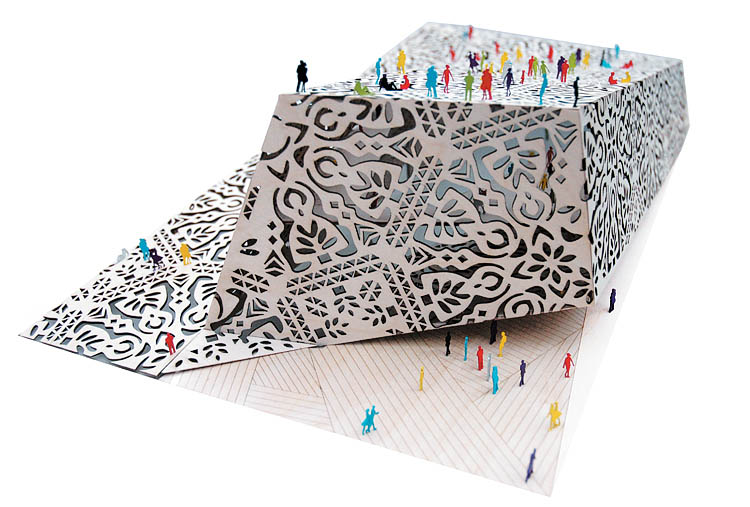 [Image: A rendering of the Polish Pavilion, designed for the 2010 World Expo in Shanghai]. [Image: A rendering of the Polish Pavilion, designed for the 2010 World Expo in Shanghai].Architects Wojciech Kakowski, Natalia Paszkowska, and Marcin Mostafa will be designing the Polish Pavilion for Shanghai's World Expo in 2010. The building's design, the architects write in a mass-circulated press release, was required to "denote, by its esthetic distinctiveness, the country of origin," and it had to "constitute, by the strength of its stylistic connotations, an evocative, recognizable and memorable cultural ideogram." In this case, the "cultural ideogram" their winning design was meant to embody is "the motif of folk-art paper cut-out[s]."  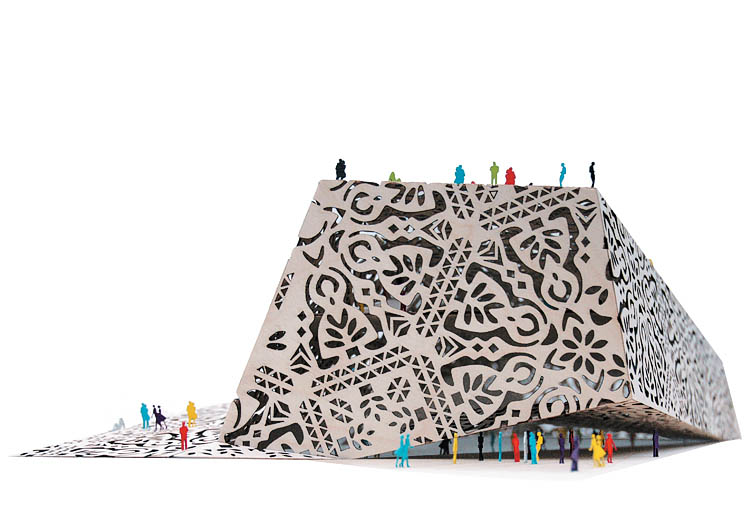 [Images: Two more views of the Polish Pavilion, designed for the 2010 World Expo in Shanghai]. [Images: Two more views of the Polish Pavilion, designed for the 2010 World Expo in Shanghai].As the below diagram makes clear, this "paper cut-out" theme has been taken quite literally: the outer envelope of the building is actually a kind of incised wrapper, capable of unfolding to form a flat surface again (albeit one in which the patterns do not always match up). 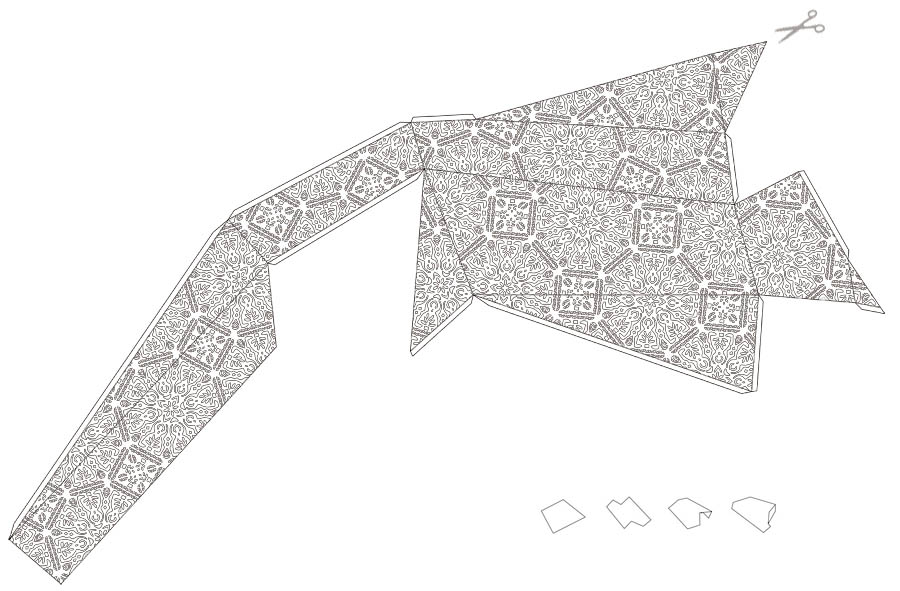 [Image: A structural diagram of the building's exterior, unfolded]. [Image: A structural diagram of the building's exterior, unfolded].So is this mere ornament, nostalgia, and postmodern reference? Or is today's growing inclination for decorative hyper-complexity in architecture put to interesting and novel use? On an unrelated note, I feel like this is the type of structure we'll someday learn has been entirely 3D printed. It also makes me think of the gorgeously baroque plasma-cut sculptural work of artist Cal Lane, as recounted last week on materialicious. Read more at the project's website.
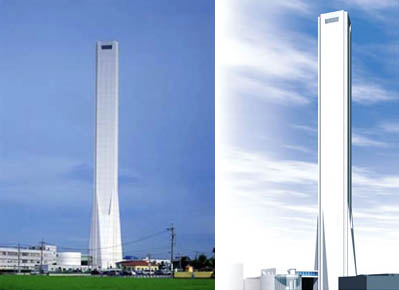 [Images: Mitsubishi's new elevator testing tower in Japan]. [Images: Mitsubishi's new elevator testing tower in Japan].Mitsubishi has opened a "test tower," built for experimental new elevator designs and technologies. It's "the world's tallest elevator testing tower" – and it's a functionalist monolith, standing at 567 feet. It's just one gigantic elevator shaft. The building will be used "to conduct research into high-speed elevators to serve the next generation of super-tall buildings," including stress tests on "new drives, gears, cables and other lift systems." I see at least one scene from Mission Impossible IV being filmed here – there's some sort of world-destroying nuclear device hidden above that vertical maze of moving platforms and our hero's got to find it... Or perhaps some future game world called Batman: Japan, in which the Caped Crusader lives and works entirely in various locations throughout the Japanese archipelago, burning incense and punching through Cor-Ten steel blocks in an underlit dōjō near the sea. One night he follows a lone criminal back to what looks like a vertical fortress... only it's not a fortress: it's this weird experimental elevator complex looming over him in the darkness. He enters. He hears machines. Hijinks ensue.
A story I've been meaning to write about for several weeks now involves a family in South Carolina who moved into a newly purchased house. They were all messing about one day, doing chores, cleaning up, moving in, when they "found a secret room in their home behind a bookcase" – but "what was inside," we read, "was a nightmare beyond their wildest dreams."  [Image: A suburban house that is otherwise unconnected to this post]. [Image: A suburban house that is otherwise unconnected to this post].Inside the room was a hand-written note. The note said "You Found It!" It turns out, the note explained, that the house was infested with "the worst types of mold including Stachybotrys, the so-called Toxic Black Mold," which can cause " respiratory bleeding" in infants. 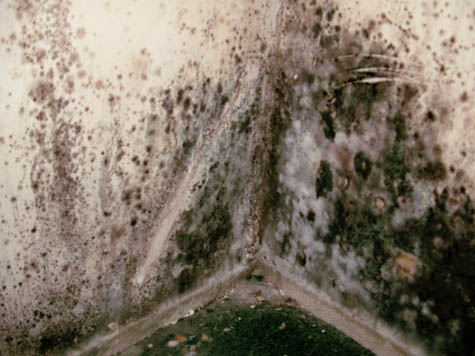 [Image: Toxic black mold]. [Image: Toxic black mold].The stunned homeowners, thinking they might be the victims of a weird hoax, hired an environmental engineer – only to discover that the problem was even worse than they thought; the house contained "elevated levels of several types of mold, including Aspergillus, Basidiospores, Chaetomiu, Curvularia, Stachybotrys and Torula." The town's local news station calls this "the horrible secret of Number 6 Whitten Street." (Thanks, David W.!)
|
|
 [Image: Some examples of work by Imaginary Forces].
[Image: Some examples of work by Imaginary Forces].
 [Image: ©Michael Nagle for
[Image: ©Michael Nagle for  [Image: Courtesy of
[Image: Courtesy of  [Image: A photo from Jacob Carter's ridiculously gorgeous
[Image: A photo from Jacob Carter's ridiculously gorgeous  [Image: Another one from Jacob Carter's
[Image: Another one from Jacob Carter's  The author "claimed to have become so intoxicated" by the fumes that "she was reduced to writing thrillers." Indeed, the fumes grew so intense "that she was unable to concentrate on writing her highbrow novel, Cool Wind from the Future, and instead wrote a brutal crime story, Bleedout, which she found easier."
The author "claimed to have become so intoxicated" by the fumes that "she was reduced to writing thrillers." Indeed, the fumes grew so intense "that she was unable to concentrate on writing her highbrow novel, Cool Wind from the Future, and instead wrote a brutal crime story, Bleedout, which she found easier."  [Image: Photo by Eran Brokovich for
[Image: Photo by Eran Brokovich for  I believe, as well, that I'll be introduced by
I believe, as well, that I'll be introduced by  It's a speculative project, to be sure – but a fun one, and I can't wait to see what comes up.
It's a speculative project, to be sure – but a fun one, and I can't wait to see what comes up.  Continuing:
Continuing: [
[ [Image:
[Image:  [Image: Maison elastique by
[Image: Maison elastique by 

 [Images: More views of Elastic Houses by
[Images: More views of Elastic Houses by  [Image: By Steve Lambert and Packard Jennings – you must
[Image: By Steve Lambert and Packard Jennings – you must  [Image: By Steve Lambert and Packard Jennings –
[Image: By Steve Lambert and Packard Jennings – 

 [Images: By Steve Lambert and Packard Jennings – view larger:
[Images: By Steve Lambert and Packard Jennings – view larger:  [Image: Photograph ©
[Image: Photograph © [Image: From
[Image: From  These "fields of shiny crops," the
These "fields of shiny crops," the  [Image: A rendering of the
[Image: A rendering of the 
 [Images: Two more views of the
[Images: Two more views of the  [Image: A structural diagram of the building's exterior, unfolded].
[Image: A structural diagram of the building's exterior, unfolded]. [Images:
[Images:  [Image: A suburban house that is otherwise unconnected to this post].
[Image: A suburban house that is otherwise unconnected to this post]. [Image:
[Image: 


